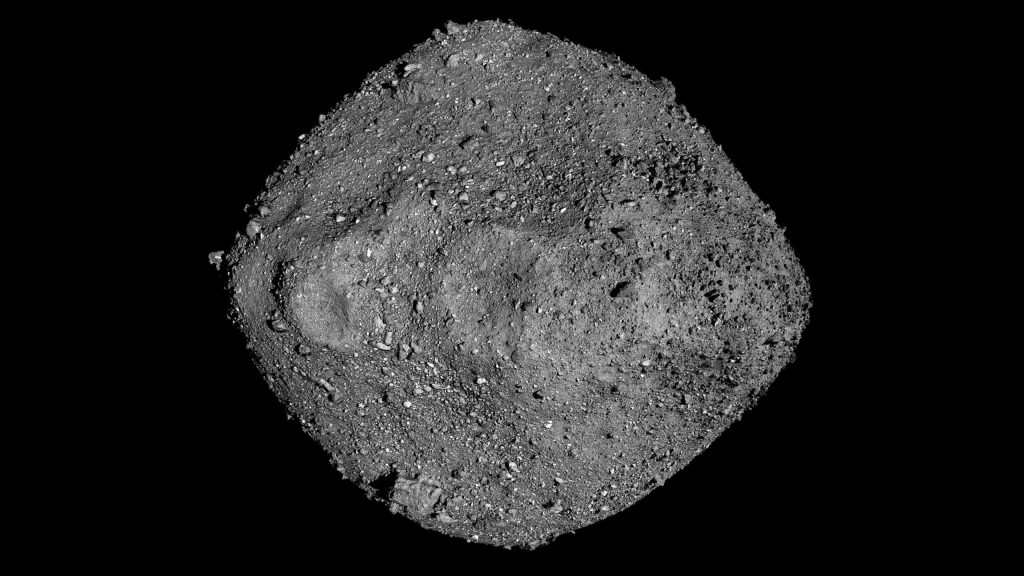
por

Este mosaico del asteroide Bennu se creó utilizando las observaciones de la nave espacial OSIRIS-REx de la NASA, que ha estado muy cerca del asteroide durante más de dos años. Crédito: NASA/Goddard/Universidad de Arizona
Recientemente, estudiosos de Misión OSIRIS-REx de la NASA Descubrió que la renovación de la superficie se produce en los asteroides mucho más rápidamente que en la Tierra. Mediante el análisis de imágenes de alta resolución de fracturas de rocas en el asteroide Bennu, tomadas por[{» attribute=»»>OSIRIS-REx spacecraft, the researchers discovered that the Sun’s heat fractures rocks on Bennu in only 10,000 to 100,000 years. With the use of this knowledge, scientists will be able to better predict the time it takes boulders on asteroids like Bennu to fragment into smaller pieces, some of which may eject into space while others may remain on the asteroid’s surface.
Although tens of thousands of years might sound pretty slow, “we thought surface regeneration on asteroids took a few millions of years,” said Marco Delbo, senior scientist at Université Côte d’Azur, CNRS, Observatoire de la Côte d’Azur, Laboratoire Lagrange, Nice, France, and lead author of a paper published in June 2022 in the journal Nature Geoscience. “We were surprised to learn that the aging and weathering process on asteroids happens so quickly, geologically speaking.”
Although landslides, volcanoes, and earthquakes may abruptly alter the Earth’s surface, most changes occur gradually. Over millions of years, water, wind, and temperature changes slowly erode rock to create new surfaces. For instance, if you hiked into the Grand Canyon, you would see distinct rock layers; the top layers tend to be the youngest rocks, dating around 270 million years old, and the layers at the bottom of the canyon are the oldest, about 1.8 billion years old. The Colorado River has been chiseling away at rocks in the Grand Canyon for 5 million to 6 million years, according to the U.S. National Park Service.

The PolyCam aboard NASA’s OSIRIS-REx spacecraft provided high-resolution, microscope-like images of asteroid Bennu’s surface. This made it possible for researchers to map more than 1,500 rock fractures. Credit: NASA/Goddard/University of Arizona
Rapid temperature changes on asteroid Bennu create internal stress that fractures and breaks down rocks, comparable to how a cold glass breaks under hot water. On Bennu, the Sun rises every 4.3 hours. At the equator, daytime highs can reach almost 260°F (about 127°C), and nighttime lows plummet to nearly minus 10°F (about minus 23°C).
OSIRIS-REx scientists spotted cracks in the rocks in spacecraft images from the first surveys of the asteroid. All of the fractures seemed to point in the same direction, “a distinct signature that temperature shocks between the day and the night could be the cause,” said Delbo.

Same image as above, but with the fractures highlighted in red. Credit: NASA/Goddard/University of Arizona
Delbo and his colleagues measured the length and angles of more than 1,500 fractures in OSIRIS-REx images by hand: some shorter than a tennis racket, others longer than a tennis court. They found the fractures predominantly align in the northwest-southeast direction, indicating they were caused by the Sun, which is shown here to be the primary force changing Bennu’s landscape.
“We were surprised to learn that the aging and weathering process on asteroids happens so quickly, geologically speaking.” — Marco Delbo
“If landslides or impacts were moving boulders faster than the boulders were cracking, the fractures would point in random directions,” said Delbo.
The research team used a computer model and their fracture measurements to calculate the 10,000- to 100,000-year timeframe for thermal fractures to propagate and split rocks.
“The thermal fractures on Bennu are quite similar to what we find on Earth and on Mars in terms of how they form,” said Christophe Matonti, a co-author of the paper at Université Côte d’Azur, CNRS, Observatoire de la Côte d’Azur, Géoazur, Sophia-Antipolis, Valbonne, France. “It is fascinating to see that they can exist and are similar in very ‘exotic’ physical conditions [low gravity, no atmosphere]Incluso en comparación con Marte.
Jason Dworkin, científico del proyecto OSIRIS-REx en Centro de Vuelo Espacial Goddard de la NASA en Greenbelt, Maryland.
OSIRIS-REx (Orígenes, Interpretación espectral, Identificación de recursos, Seguridad-Regolith Explorer) Devolverá una muestra de Bennu a la Tierra. El 24 de septiembre de 2023. «Podremos conocer más detalles sobre la edad de la superficie cuando podamos estudiar la muestra directamente», dijo Dworkin.
Referencia: «Alineación de fracturas en rocas Bennu indicativas de una rápida evolución de la superficie de asteroides» por Marco Delpo, Kevin J Walsh, Christoph Mattonti, Justin Wilkerson, Maurizio Pagola, Manar the Lion, Chrisa Avdelido, Ronald Lewis Blues, Karina A. Bennett, Harold C. Connolly Jr y Daniela Dellagiostina, Dathon R. Gulish, Jimmy L. Molaro, Bashar Rizk y Stephen R. ciencias naturales de la tierra.
DOI: 10.1038 / s41561-022-00940-3





More Stories
¿Cómo se hicieron los agujeros negros tan grandes y rápidos? La respuesta está en la oscuridad.
Una vaca marina prehistórica fue devorada por un cocodrilo y un tiburón, según los fósiles
El lanzamiento del cohete Falcon 9 de SpaceX se ha detenido a medida que se acercan dos importantes misiones de vuelos espaciales tripulados.